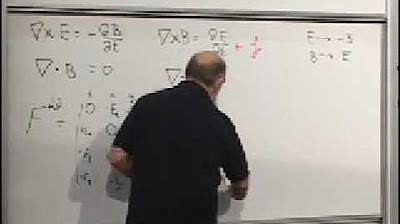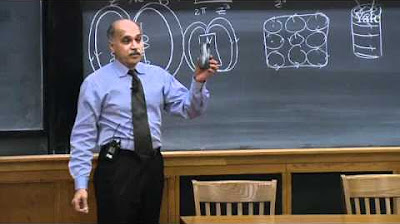Why moving charges produce magnetic field?
TLDRThis script explores the concept of moving charges and their relation to magnetic fields through the lens of Einstein's theory of relativity. It challenges the traditional understanding of magnetic fields by suggesting that all observed effects can be explained using Coulomb's law and relativistic effects like length contraction and time dilation. The video script delves into how these relativistic phenomena can account for the forces experienced by moving charges, offering a fresh perspective on the unification of electric and magnetic fields as different manifestations of a single electromagnetic force.
Takeaways
- 🧲 The script explores the concept of moving charges producing magnetic fields from a new perspective using Einstein's theory of relativity.
- 🤔 It questions the traditional explanation of why moving charges produce magnetic fields, challenging the notion with Einstein's ideas about fields being relative.
- 📚 The script uses Coulomb's law as a basis for explaining the interactions between charges without invoking magnetic fields.
- 🚀 Einstein suggests that the force experienced by a moving charge near a current-carrying wire can be explained by considering the wire as charged from the moving charge's reference frame, due to length contraction.
- 🌌 Length contraction, a consequence of relativity, implies that moving objects appear shorter in the direction of motion, affecting how charges are distributed within a wire.
- ⚛️ The script explains that from the perspective of a moving electron, protons in the wire come closer together, making the wire appear positively charged, thus attracting the electron via Coulomb's law.
- ⏱ Time dilation, another relativistic effect, is introduced to explain why two moving charges separate more slowly than expected, attributing this to the slowing down of time rather than a magnetic force.
- 🔍 The script suggests that magnetic fields might not be a separate entity but a transformation of electric fields under different reference frames.
- 🔗 It emphasizes that electric and magnetic fields are aspects of a unified electromagnetic force, a concept that is reconciled through the theory of relativity.
- 💡 The video raises questions about the intrinsic electron spin and its associated magnetic field, which cannot be explained away simply by relativistic effects.
- 🔋 The script ends with a thought-provoking question about charge conservation and the seeming paradox of charge appearance due to relativistic effects, prompting further thought on the nature of charge in different frames of reference.
Q & A
Why do moving charges produce magnetic fields?
-According to the script, moving charges are traditionally thought to produce magnetic fields because they can deflect a magnetic needle, acting like a magnet. However, Einstein's perspective suggests that this phenomenon can be explained without invoking magnetic fields, using only Coulomb's law within different reference frames.
How does Einstein's theory of relativity relate to the magnetic effects of moving charges?
-Einstein's theory of relativity, particularly the concepts of length contraction and time dilation, can explain the magnetic effects of moving charges without the need for magnetic fields. Length contraction causes the apparent charge distribution in a wire to change when viewed from the reference frame of a moving charge, while time dilation affects the perceived speed of interactions between moving charges.
What is Coulomb's law and how does it relate to the force between moving charges?
-Coulomb's law states that the force between two point charges is directly proportional to the product of the charges and inversely proportional to the square of the distance between them. In the script, it is suggested that the force experienced by a moving charge near a current-carrying wire can be explained by Coulomb's law, considering the changed apparent charge distribution due to the moving reference frame.
What is the concept of length contraction in the context of moving charges and magnetic fields?
-Length contraction is a relativistic effect where the length of an object moving relative to an observer appears shorter along the direction of motion. In the script, it is used to explain how a wire can appear charged from the perspective of a moving electron due to the contraction of the wire and the spreading out of electrons within it.
What is time dilation and how does it affect the observation of moving charges?
-Time dilation is another consequence of Einstein's theory of relativity, stating that time appears to pass more slowly for an object moving relative to a stationary observer. In the script, it is suggested that time dilation can explain why two moving electrons separate more slowly than expected based on Coulomb's law alone.
How does the script challenge the traditional understanding of magnetic fields?
-The script challenges the traditional understanding by proposing that magnetic fields may not be a separate entity but rather a manifestation of electric fields under different reference frames. It suggests that what appears as a magnetic field in one frame could be seen as an electric field in another due to relativistic effects.
What is the significance of charge conservation in the context of the script's discussion?
-Charge conservation is a fundamental principle stating that the total charge in an isolated system remains constant over time. The script raises a question about how charge conservation is maintained when the apparent charge distribution in a wire changes due to relativistic effects, suggesting that a deeper understanding of the interaction between relativity and charge conservation is needed.
Why does the script suggest that magnetic fields might not be a separate force from electric fields?
-The script suggests that magnetic fields might not be separate forces because both electric and magnetic fields can be seen as different manifestations of the same underlying electromagnetic force. This unification is supported by Einstein's theory of relativity, which shows that the effects attributed to magnetic fields can be explained by the motion of electric charges.
What is the role of the electron's reference frame in explaining the magnetic effects of moving charges?
-In the electron's reference frame, the script explains that the moving charges (protons in the wire) cause the wire to appear charged due to length contraction. This change in apparent charge distribution can then be used to explain the force experienced by the electron using Coulomb's law, without the need for magnetic fields.
How does the script address the apparent paradox of charge conservation when considering relativistic effects?
-The script acknowledges the apparent paradox but suggests that a complete understanding of the situation requires considering the entire system, such as a circuit with a battery. It implies that charge conservation must still hold true when changing reference frames, and that the extra apparent charge is not created but is a result of the relativistic transformation of the system.
Outlines
🧠 Rethinking Magnetic Fields Through Relativity
The script introduces a thought-provoking perspective on why moving charges produce magnetic fields, challenging the traditional explanation. It proposes Einstein's theory of relativity as a means to explain the phenomenon without invoking magnetic fields. The speaker uses the example of a current-carrying wire and a magnetic needle to illustrate the conventional understanding and then suggests that Einstein might offer a different explanation using Coulomb's law. The conversation delves into the complexities of charge interactions and the traditional explanations of magnetic effects, setting the stage for a deeper exploration of relativity's role in electromagnetism.
🔍 Exploring Length Contraction and Charge Apperance
This paragraph delves into Einstein's theory of relativity, specifically length contraction, to explain the force experienced by a moving charge near a wire. It describes how, from the perspective of a moving electron, the wire's protons appear to move and the wire contracts, seemingly becoming charged. This apparent charge, according to Einstein, is what attracts the electron, aligning with Coulomb's law. The script discusses the implications of this perspective, suggesting that what we perceive as magnetic fields might be the result of relativistic effects. It also raises questions about the equivalence of forces calculated through length contraction versus traditional magnetic explanations, hinting at the deeper connections between electricity and magnetism.
🕰 Time Dilation and the Slow Separation of Charges
The script continues to challenge traditional electromagnetic concepts by discussing time dilation, another consequence of Einstein's theory of relativity. It uses the example of two moving electrons, which, contrary to expectations based on Coulomb's law, separate more slowly than predicted. The explanation provided is that in the lab reference frame, the moving electrons experience time dilation, making their separation appear slower. The script argues that this effect, rather than a magnetic force, is responsible for the observed phenomenon. This leads to a broader discussion about the unification of electric and magnetic fields into a single electromagnetic field, suggesting that relativity reveals their interconnectedness.
🌀 The Paradox of Charge Conservation and Relativity
In the final paragraph, the script addresses a potential paradox regarding charge conservation in the context of relativity. It questions the source of the apparent charge on a conductor when observed from the reference frame of a moving electron. The script suggests that while relativity can alter perceptions of charge distribution, it cannot violate the principle of charge conservation. It invites the audience to consider the larger circuit and the role of a battery in maintaining this conservation, leaving the audience with a thought-provoking question about the fundamental principles of electromagnetism and the deeper implications of relativity.
Mindmap
Keywords
💡Magnetic Fields
💡Einstein's Relativity
💡Coulomb's Law
💡Current-Carrying Wire
💡Length Contraction
💡Time Dilation
💡Moving Charges
💡Deflection
💡Electric Field
💡Electromagnetic Force
Highlights
The video explores the concept of moving charges producing magnetic fields from a new perspective using Einstein's theory of relativity.
It challenges the traditional understanding of magnetic fields by questioning why moving charges are said to produce them.
Einstein proposes explaining the phenomena of moving charges without invoking magnetic fields, using only Coulomb's law.
The example of a current-carrying wire and a moving charge is used to illustrate the traditional explanation of magnetic attraction.
The video explains the paradox of a current-carrying wire appearing uncharged when it should attract or repel a moving charge.
Einstein suggests considering the situation from the moving charge's reference frame to understand the force acting on it.
The concept of length contraction from relativity is introduced to explain how the wire appears charged in the electron's reference frame.
The video demonstrates that length contraction causes protons in the wire to come closer together, making the wire appear positively charged.
Coulomb's law is used to explain the attraction between the positively charged wire and the electron, without the need for a magnetic field.
The video addresses the question of whether the force calculated using length contraction matches traditional magnetic force calculations.
It discusses the negligible but cumulative effect of length contraction over many protons and electrons, leading to a macroscopic effect.
The video provides an alternative explanation for why two moving electrons separate slower than expected, using time dilation instead of magnetic force.
Time dilation is explained as the reason for the slower separation of moving electrons, rather than an additional magnetic force.
The video raises the question of whether magnetic fields are an illusion and if electric fields are the fundamental phenomenon.
It suggests that electric and magnetic fields might be different manifestations of a single electromagnetic field.
The video concludes by discussing the apparent paradox of charge conservation when changing reference frames in relativity.
It emphasizes the importance of charge conservation as an absolute concept that must hold true regardless of reference frame changes.
Transcripts
Browse More Related Video
5.0 / 5 (0 votes)
Thanks for rating:





